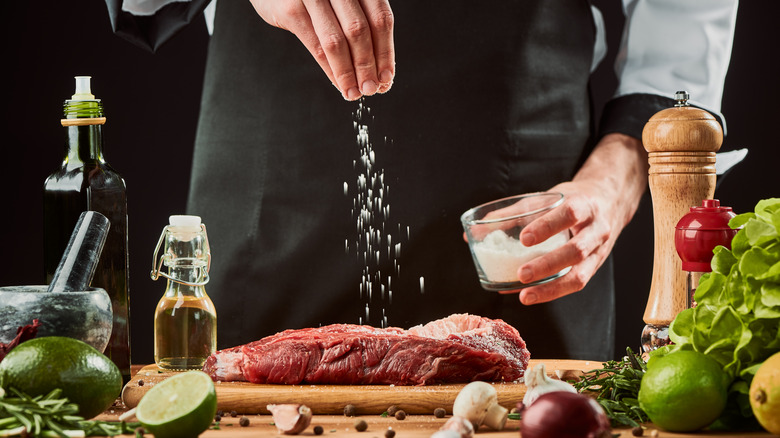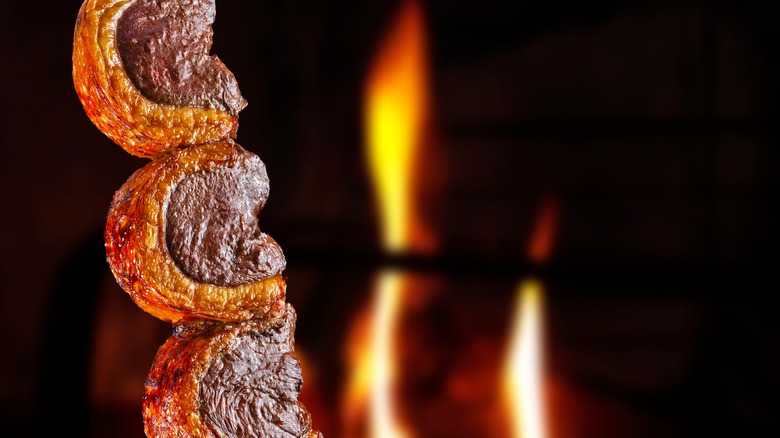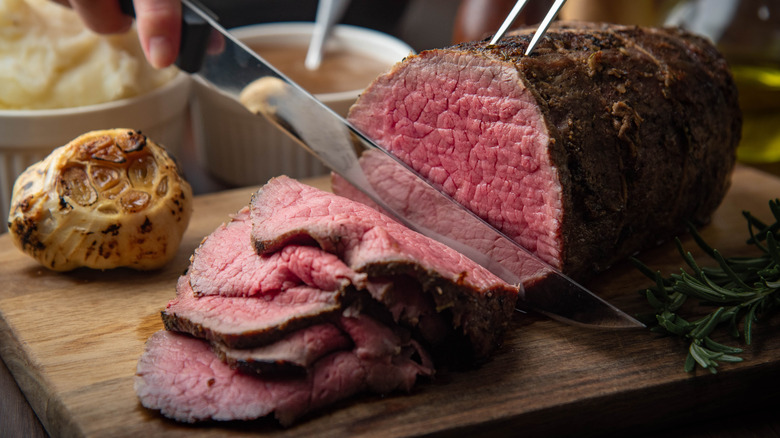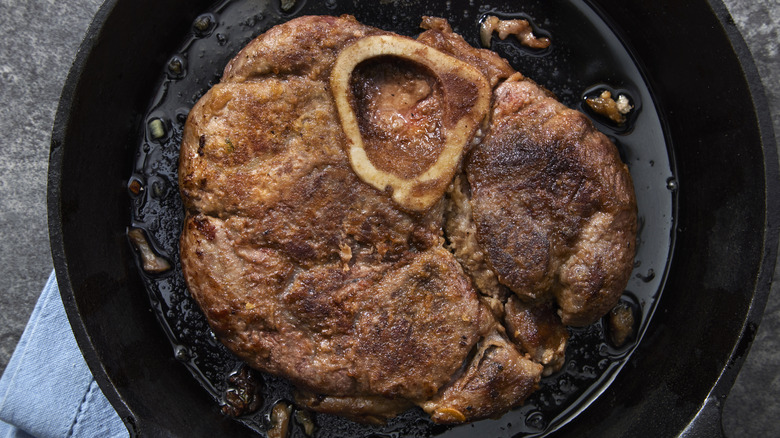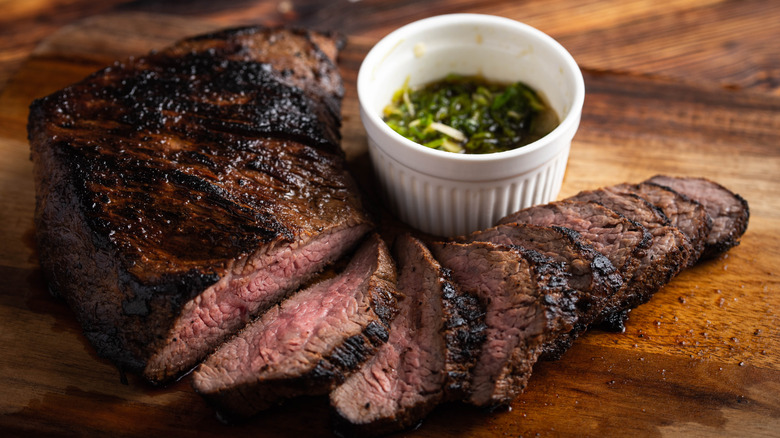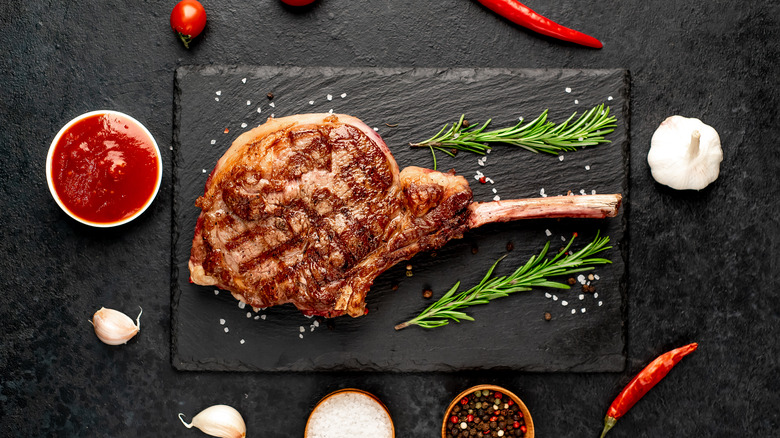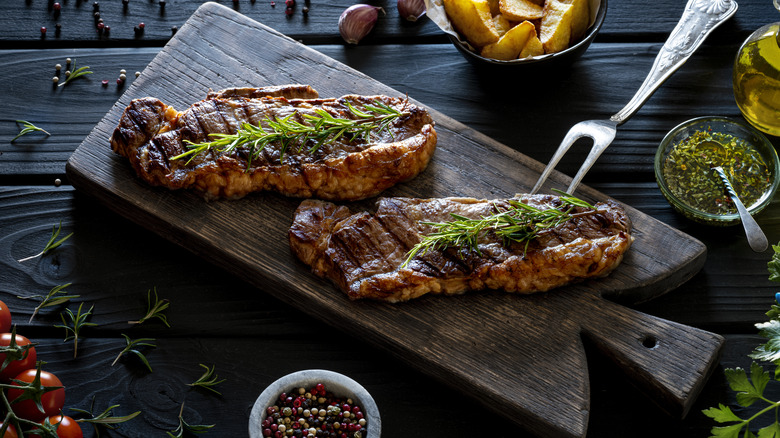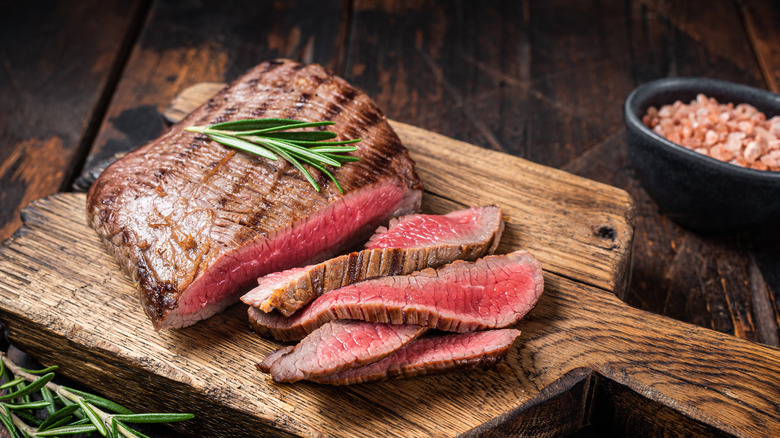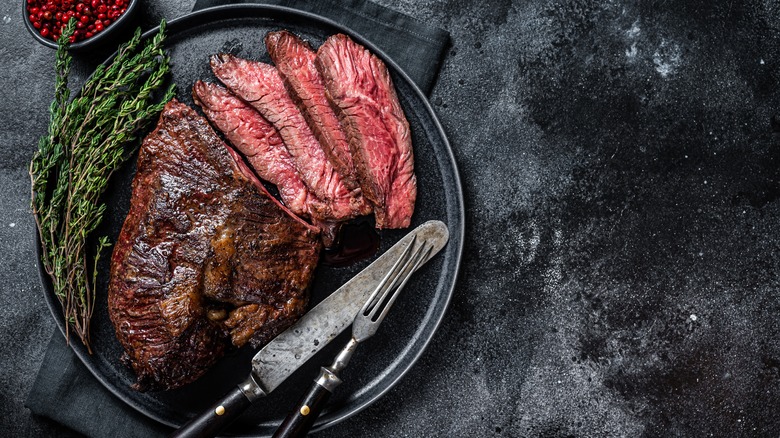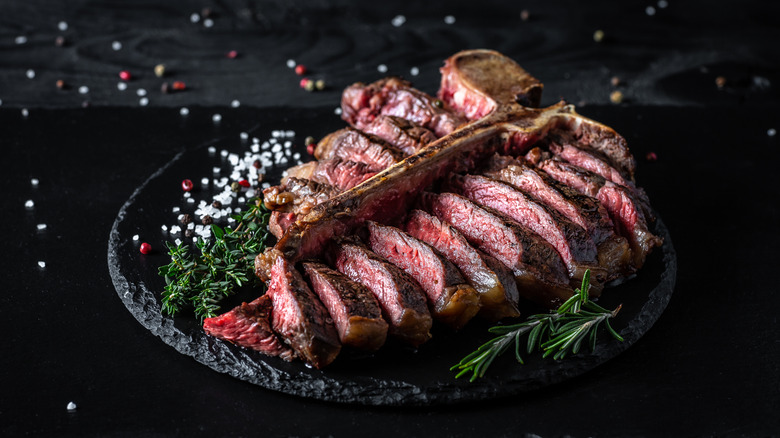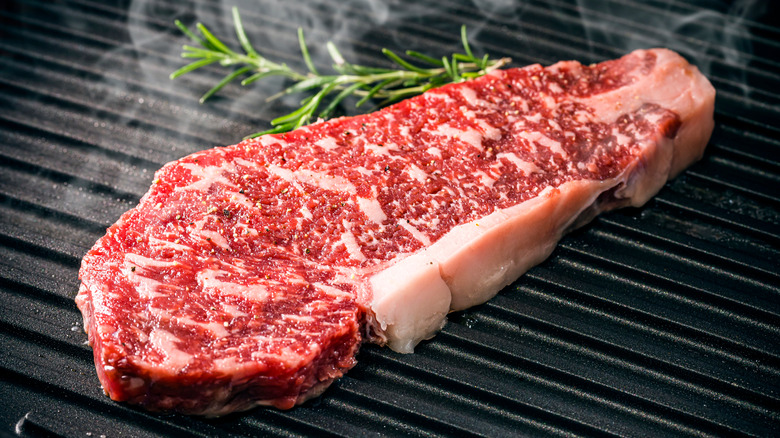11 Cuts Of Steak That Always Taste Better At A Restaurant
Steak is one of those foods that screams special occasion to a carnivore. The savory aroma, luscious texture, and umami-rich taste can make your mouth water just thinking about it. Nowadays, preparing a dynamite steak at home isn't as complex as it used to be. Between high-end cooktops, expensive cookware, and access to the finest cuts of meat money can buy, even a home cook can create the juiciest steak out there. That said, some steaks still taste better when ordered at a restaurant.
Restaurants have a few advantages that even the most well-equipped and experienced home cooks cannot compete with. Commercial equipment is designed to produce high-quality results with even the most fickle cuts of meat. From high-end grills to pressure cookers to sousvide units, chefs can transform tough cuts faster and easier than lay people at home. And let's be honest, chefs at a restaurant often have the specialty training and experience necessary to coax the maximum flavor and texture out of virtually any food or beverage.
As a chef, there are a few cuts that I recommend you order when dining out, due to their probabilities for success when prepared in professional kitchens. These may not always be the most expensive cuts, but they end up getting the attention they need to elevate them to their highest potential. Read on to discover which cuts of steak always taste better at restaurants and why.
1. Picanha
If you have ever dined at a Brazilian steakhouse or sampled some Brazilian barbecue, you may have encountered a particularly buttery cut of beef known as picanha. Often known as "The Queen of Steaks," this crescent moon-shaped cut with a distinctive thick layer of fat comes from the rump or butt of the cow. In America, this cut is known as the sirloin, rump cap, or coulotte, and it's frequently divided into lesser diminutive cuts where the rich fat layer is removed, such as the loin or round steaks.
Because it is more challenging to find stateside, this steak is best enjoyed while dining at a restaurant, particularly at churrascarias (Brazilian steakhouses), where the meat is cooked churrasco-style: on an open fire using large skewers. This high-heat cooking method ensures that the exterior of this cut gets well seared and the interior remains moist and tender. The resulting meat has a smoky richness, complementing the delicate mild umami flavor and showcasing its luxurious texture.
Assuming you could even find a picanha cut of beef, you will never be able to replicate the distinctive flavor and texture conferred by the churrasco method for cooking picanha at home. Additionally, there is something special about the multisensory experience of dining at a churrascaria that enhances the flavor of this cut. At a Brazilian steakhouse, the parade of meat on display, as well as the myriad of side dishes served, perfectly accompany the picanha, making this cut better enjoyed at a restaurant.
2. Round steak
Round steaks originate in the cow's hind quarters and can be divided into top and bottom cuts. The top round hails from the inner portion of the back legs, while the bottom round comes from the exterior of the same legs. Because of the location of the round, these cuts are known for lacking intramuscular fat or marbling, while having tremendous quantities of connective tissue. Both of these qualities are by-products of the amount of exercise these back leg muscles undergo.
Round cuts are cost-effective but can take a tremendous amount of finesse to cook. They often require low and slow cooking methods, like braising, that can break down the collagen within those dense connective tissues, tenderizing them and creating a luscious bite. Restaurants have the advantage of culinary devices like sous vide units, which can help yield a steak that will not require a jackhammer to chisel through.
These steaks will often appear on a menu as a London Broil. The London Broil – though often thought of as a particular cut of beef — is a cooking technique involving marinating the meat in acid for an extended period — to help soften and flavor it — before cooking it using a high-heat technique such as grilling or broiling. The meat is always cooked rare to medium-rare to keep it moist before it is allowed to rest. Once rested, the London Broil is typically sliced thinly against the grain, creating a less toothsome experience.
3. Shank
The beef shank generally is a cut of meat that comes from the upper leg of the cow, between the knee and hip or shoulder. This cut can be divided into two types: the fore and hind shanks. The former stems from the front legs, while the latter is cut from the back legs. This steak is typically cut horizontally through the bone, yielding an approximately 1-inch thick portion with a distinctive eye in the center, where the marrow is located.
Because this cut of meat stems from a portion of the animal that moves a lot, it is exceedingly lean and punctuated by connective tissue, bone, and joints. Slow cooking methods are required to break down this sinewy cut, allowing the meat to yield, the collagen to render out, and the marrow the chance to soften to gelatinous, buttery perfection.
While a home cook could transform this cost-effective cut, its preparation is better left to restaurants. Restaurants benefit from time, proper equipment, and know-how to transform this cut of meat into something elegant and luxurious. The most classic menu item that features the shank is a velvety Osso Bucco. This stew is often made from red wine, tomatoes, and aromatics. If you see it on the menu, do not skip it. This dish is a revelatory experience.
4. Tri-tip steak
One of the main reasons to order a tri-tip steak at a restaurant is that you won't often find it at the grocery store or butcher shop. This distinct cut of meat hails from the sirloin subprimal portion of the cow. The cut, as its name implies, is the triangular-shaped bottom tip of the sirloin. It typically weighs between 1.5 and 2.5 pounds. While lean, it does have a fair amount of intramuscular fat or marbling, making it ideally suited for high-heat cooking methods like grilling, broiling, or pan-searing.
Look for one of its other monikers if you have trouble finding this cut on a restaurant menu. It is often listed under "California's Cut" or "Santa Maria Steak" owing to the town located on the Central Coast of California, where it was popularized in the 1950s. This cut may be found whole or sliced into 1-inch thick steaks. It is always served rare to medium-rare to ensure it remains juicy and supple.
Another reason to leave this cut to the professionals is its distinct morphology. The tri-tip is divided into two segments separated by dense connective tissue. This can be removed before cooking the tri-tip in two segments, or an experienced chef has to carve these segments accordingly, as they have muscle fibers (or grains) that run contradictory to one another. Each half must be sliced against the grain for the meat to be moist and delectable.
5. Tomahawk or cowboy steak
Bone-in cuts are always recommended when dining at a restaurant. The presence of the bone can make it cook unevenly, making it a challenge to obtain uniform doneness without extensive experience. Tomahawk and cowboy steaks are bone-in steaks that are well-suited to restaurant preparation. These cuts take advantage of an in-house butcher, or access to specialty meat purveyors, for which restaurants are uniquely equipped.
The Tomahawk and the cowboy steak are bone-in ribeye cuts that taste similar. They have decent marbling and are well-suited to high-heat cooking, as they're located in a part of the cow that's seldom exercised. These steaks are cut roughly 2 inches thick, which is the diameter of the rib bone. The rib bone is subsequently frenched, meaning any residual fat is removed from it. This creates a handle from which you can gnaw the delectable meat.
Where the steaks differ is in size. The Tomahawk is more ample, because of the layer of fat retained surrounding the meat. This is removed for a cowboy steak. The attached bone is also longer on a Tomahawk than on a cowboy steak, making it more dramatic when presented on a plate. These are not steaks for the faint of heart, averaging 45 ounces in weight. Also, they are not cheap, as they require extra effort to butcher accordingly. If you see either on the menu, you might want to split the order, as it can easily feed a party of two.
6. Strip steak
The strip steak, also known as New York strip steak, ambassador steak, strip loin steak, Kansas City strip, and club steak, is a tender boneless cut that hails from the short loin of the cow. This muscle is nestled beneath the spine and encased by the rib cage, a region of the animal that does little work, yielding meat that is tender and rife with intramuscular fat. The strip has the richness of flavor of a filet mignon with a slightly firmer texture. This requires a touch more experience when cooking than the filet.
Because the strip steak is quite pricey and less forgiving than a filet, chefs recommend ordering it at a restaurant rather than cooking it at home. If you prefer your meat on the medium to well-done side, this is not the steak for you. It should be prepared rare to medium-rare for maximum flavor and texture. While this steak benefits most from high-heat cooking methods, like grilling, broiling, or reverse pan-searing, restaurants often give this cut the sous vide treatment. Doing so ensures the entire stip steak is evenly cooked before the exterior is pan-seared to perfection for that golden, crispy crust.
7. Skirt steak
Skirt steak is a flat, thin cut of beef approximately ½ inch thick and can weigh from 1 to 2 pounds. It is sourced from the plate, or belly region (essentially the diaphragm). It gets its name from its distinct muscle fibers, which span the breadth of the skirt steak, giving it the appearance of a pleated skirt.
While it may sound counterintuitive, this cut comes from a muscle that does get a fair amount of exercise, making it lean and rife with connective tissue. Generally, cuts like this benefit from slow cooking, but because of the thinness of this particular steak, it responds better to higher-heat cooking methods. This can make the skirt steak particularly challenging to cook without being under or overdone, making an experienced chef invaluable in this case. Its ideal doneness should be medium-rare, with a good sear on the exterior.
Restaurant chefs will counteract the persnickety nature of this cut of meat by using two methods of preparation to enhance flavor and improve suppleness. First, they may score the exterior of this cut with a knife to help cut through those dense muscle fibers. Alternatively, the cut will be soaked in an acidic marinade to break down those connective tissues. Regardless of preparation and cooking method, the key to ensuring this steak remains tender is understanding which direction the grain runs, so that it is correctly carved against it.
8. Bavette or flank steak
Though they are technically not identical, the bavette and flank steak are obtained from similar regions of the cow, just above the plate and below the sirloin. The bavette, or bib of the sirloin, is often called the "butcher's cut" or flap steak. Though not as commonly found as the flank steak, it shares similar characteristics of being a lengthy, flat, oval-shaped cut with dense muscle fibers lacking in the connective tissues associated with the skirt steak.
While the flank steak is thinner than the bavette and has less marbling, both are thicker and more tender than the skirt steak, making them somewhat more forgiving to cook. That said, they can still easily be overcooked if not treated with care, making entrusting their culinary care to professionals desirable. Additionally, the muscle fibers of these cuts run in the opposite direction of the skirt steak, along the length of the meat, making it critical to carve correctly against the grain.
Restaurant chefs often use high-heat cooking methods, like grilling, broiling, or pan-searing, to prepare these steaks to the proper medium-rare doneness. They may also utilize various pre-cooking techniques to coax the juiciness out of these cuts of beef. They can be tenderized using a meat mallet, but brining, marinating, or dry-curing these cuts with acidic ingredients can better help relax these dense muscle fibers.
9. Hanger steak
The hanger steak, or onglet, is another cut from the flat steak family. This cut is located between the bavette and skirt steak within the plate of the cow. It gets its name because this piece of meat hangs below the diaphragm. Often called the hanging tenderloin, this single V-shaped cut is exceedingly supple, benefitting from its location, nestled within the rib cage.
Though this cut contains more marbling than a skirt or flank steak because the muscle obtains little exercise, it is punctuated by a distinct sinewy membrane that runs down the center length of the meat. This membrane is often removed before the hangar steak is cooked, yielding two portions of roughly equal weight, approximately one pound each.
Like other flat steaks, the hangar should not be over or undercooked. When underdone, it tends to be chewy. When overdone, it dries out. Because of its slightly irregular shape, cooking this cut requires know-how. Restaurant chefs often cook this steak using high-heat methods or employ a sous vide unit before searing the exterior to perfection. Though this cut does lend itself to marinating in terms of absorbing flavor, lengthy acidic marination is unnecessary to obtain a moist result.
10. T-Bone or porterhouse steak
The T-Bone and porterhouse are obtained from the same portion of the cow, namely the short loin subprimal, which is considered the most coveted region because it obtains little exercise, yielding meat that is moist and rife with intramuscular fat or marbling. Both the T-Bone and the porterhouse are characterized by providing two cuts for the price of one — a New York strip and a filet mignon, separated by a T-shaped bone. The T-Bone contains a smaller piece of the tenderloin, while the porterhouse contains a full-sized filet mignon.
How these steaks are classified depends upon whether they come from the center or back portion of the short loin. The T-Bone is cut from the center cross-section of the short loin, while the porterhouse is sourced from the rear, making it a more substantial cut of meat. Each short loin has approximately seven T-Bones and only two or three porterhouse steaks. While all porterhouses are considered T-Bones, the opposite is not the case.
These cuts are ideal to order at a restaurant because they can be challenging to cook. The presence of the bone and two distinct steaks make these cuts cook unevenly, requiring finesse and often multiple culinary techniques. The high heat of a grill will do the job. However, often a reverse sear or using a sous vide unit to cook the meat to the desired medium-rare doneness, before finishing it off in a pan, will help maintain the tenderness of both steaks.
11. Wagyu
Wagyu is not a cut of steak, so much as a type of beef, specifically Japanese beef. The breeds of Japanese beef that qualify as Wagyu include Akage Washu (Japanese Brown), Kuroge Washu (Japanese Black), Mukaku Washu (Japanese Polled), and Nihon Tankaku Washu (Japanese Shorthorn). What makes Wagyu distinctive is the genetics of this type of cattle, which produce distinctly high intramuscular fat or marbling.
These cattle have been selectively bred and cared for to encourage prolific marbling through a highly specialized diet and rigorously monitored quality of life, free of stress. Where typical American angus cattle are processed at 18 months of age, wagyu are allowed to mature to 3 years old, during which they will gain enough fat to make up 50% of their body mass. This lengthy lifespan is partly responsible for the high cost of steaks obtained from Wagyu beef.
Though online resources for authentic Japanese Wagyu exist, American Wagyu — a cross-breed between Angus and Wagyu — is becoming increasingly popular. It may be hard to determine the precise origin or quality of a steak labeled Wagyu at a grocery store. For this reason, you should reserve an expensive Wagyu steak cut for a fine dining restaurant, where they are more likely to obtain the real deal and have the skill to cook the highly marbled meat perfectly.
